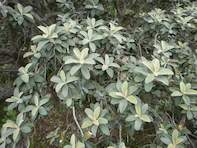Camphor bush, Tarchonanthus camphoratus is also known as leleshwa, African wild sage or ‘vaalbos’ (Afrikaans). It’s name refers to the strong camphor smell of the leaves. It is a small tree with grey leaves and grows between 2 m and 9 m high.

It’s creamy white flowers form white fluffy seed heads which were used to stuff pillows. Wild animals can often be seen rubbing against the bush. Studies indicated that these animals suffer less from insects. Similarly, it is used as bedding by the Maasai people who believes it aids in deterring insects and promotes deep sleep.
Farmers in the North West province of South Africa use young leaves of camphor bush in a feed mix due to its relative high (30%) protein content. The wood is heavy and termite resistance and ideal for musical instruments and intricate joiner’s work.
The tree has an extensive root system and is useful in the rehabilitation of dunes and to prevent soil erosion. It is fire resistant and can make good fire breaks. The plant is drought resistant, can withstand salty coastal winds and frost.
Plant material is mostly wild harvested but there are some commercial plantings in the North West and Free State provinces of South Africa. The tree grows wild in the warmer regions of East Africa, South Africa as well as Botswana and Angola.
Benefits of Camphor Bush
Camphor bush helps treat fevers, wounds and cuts and acts as a natural preservative when added to body and skin care formulations. Inhaling smoke from burning Camphor bush leaves can clear blocked sinuses and headaches while decoctions of the leaves treat coughs, toothache, bronchitis and abdominal pains.
Camphor Bush leaves are used for massaging body stiffness. An essential oil is produced by steam distillation of the leaves. This Camphor Bush oil is believed to have excellent potential in the perfume industry for its pronounced ‘male’ (spicy) notes.
It contains 0.3% of the active insect repellent ingredient and is found to be effective for 6 - 10 hours. Camphor Bush oil is also employed for its anti-irritant properties for sensitive skins, dermatitis, sunburns and bedsores.